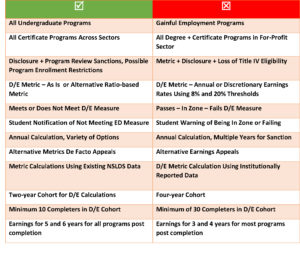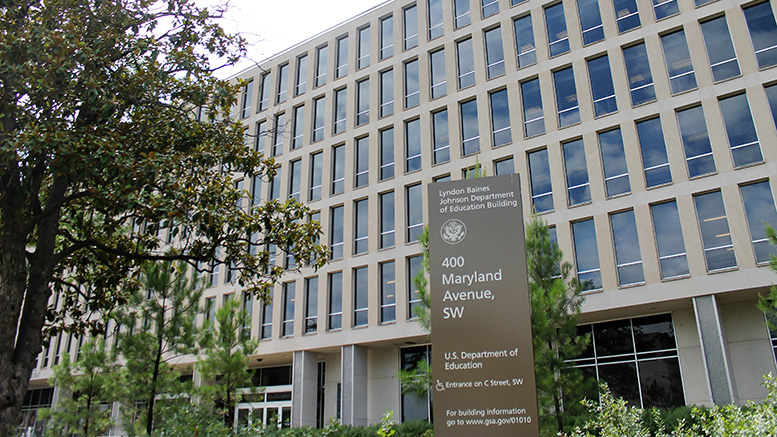Consensus was not reached earlier this month at the third and final Gainful Employment (GE) Regulations negotiated rulemaking (GE Neg Reg) session. The lack of consensus means that the Department of Education (ED) is formally free to draft regulations without taking into account negotiators’ recommendations, although presumably the extended public discussions will have an impact. Changing the GE policies has been a top priority of the current administration.
For a revised final rule to go into effect July 1, 2019, ED must have it in place no later than November 1, 2018. To meet this deadline, ED must first release its Notice of Proposed Rule Making (NPRM), elicit public comments for a period of usually 60 days, and review these comments prior to issuing the final rule. Assuming this scenario, the American Association of Community Colleges will submit comments on the proposed rules and will urge community college leaders to do likewise.
ED proposed removal of institutional reporting requirements
All non-degree programs, regardless of sector, are currently subject to the GE regulations, along with virtually all programs (including degrees) in the for-profit sector (https://ifap.ed.gov/dpcletters/GEN1512.html). Under the current regulations, for a GE program to lose Title IV federal student aid eligibility, a program has to fail the debt-to-earnings (D/E) metric two out of three consecutive years or be in a warning “zone” and failing for four consecutive years. In the first year of implementation of the existing regulations, no community college GE program (non-degree – i.e., certificate) has failed the debt-to-earnings D/E metric.
Under the current regulations, however, some community colleges have encountered considerable burdens complying with the reporting requirements. Furthermore, the information collected often does not lead to either the calculation of the D/E metric or disclosures due to the small size of GE programs, because of privacy protections. In the negotiating sessions, this view was expressed by Kelly Morrissey, director of financial aid at Mount Wachusett Community College in Massachusetts, serving as the primary negotiator for financial aid administrators. She welcomed ED’s proposal to eliminate the burden of the current reporting requirements and instead use existing administrative data from the National Students Loan Data System (NSLDS) to calculate the D/E metric. However, the NSLDS lacks information on private loans and does not distinguish direct educational costs from living expenses. This latter fact could inflate community college D/E rates from those under the current regulations.
What’s in and out in ED’s proposal
If ED issues final regulations based on its positions expressed during the Negotiated Rulemaking Sessions on Gainful Employment, here’s what we might expect by way of changes from the current rules:

The changes ED made in the draft rule between the first and last Neg Reg session and what the Department’s negotiator said that ED was willing or not willing to adopt may provide some clues as to the upcoming NPRM. The first set of proposed GE changes basically obviated the current rule by turning it into a disclosure-only regulation that would apply to all programs, not GE programs as delineated in the Higher Education Act. As proposed, it would require that a debt-to-earnings metric be calculated for all programs at all institutions. Failure to meet the measure would have to be disclosed, but no sanctions would be applied. By the third session, only undergraduate programs would be subject to the proposed regulation.
Ideas for ED’s final debt-to-earnings regulations
After the non-consensus vote towards the conclusion of the last negotiating session, each negotiator had an opportunity to voice some final ideas for ED to consider in drafting the final rule. The remarks of the primary negotiator for the public 2-year institutions, Laura Metune, vice chancellor of external affairs, California Community Colleges, focused on the regulation’s intent. She said the regulations were originally designed to target poorly performing for-profit schools and identify them before they shut down. Her second point was that ED would have a difficult time regulating all sectors when the staff at ED is being reduced. Thelma Ross, interim director of student financial aid at Prince George’s Community College (Maryland) primary negotiator for minority-serving institutions, expressed concerns about the target of the revised regulations. She stated that it should be low-income, first-generation, and minority students who needed to be protected from becoming too heavily indebted. A one-size-fits-all rule would be problematic for these students.
As is clear, community colleges continue to have a great deal at stake in the GE or other program-focused regulations. AACC will continue to report to its members on relevant developments.

